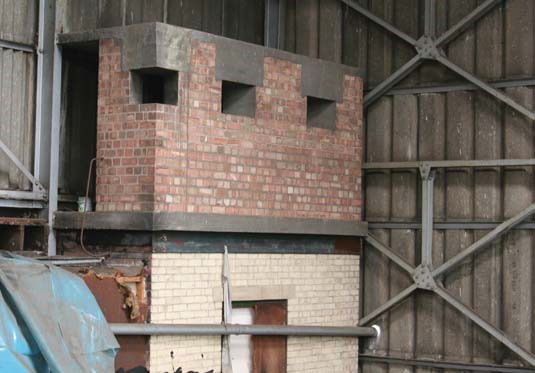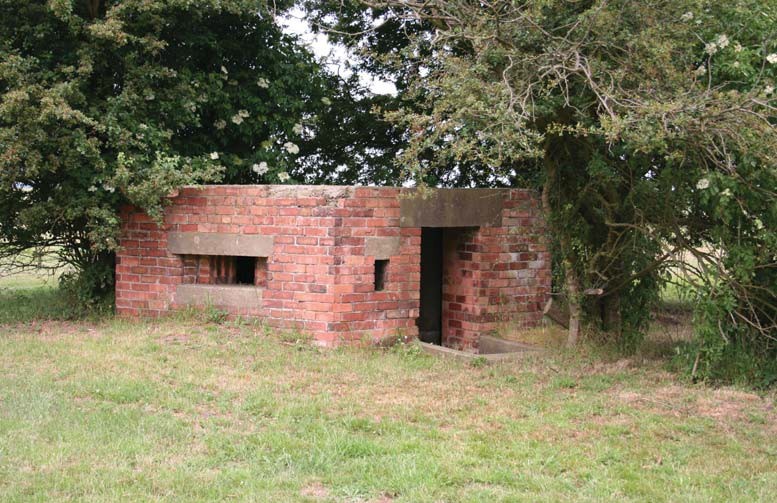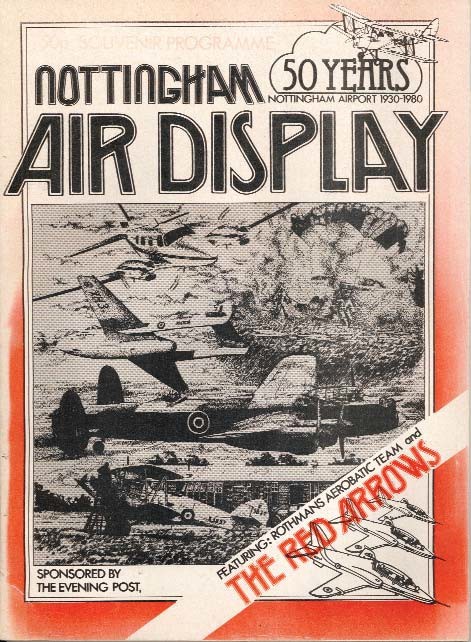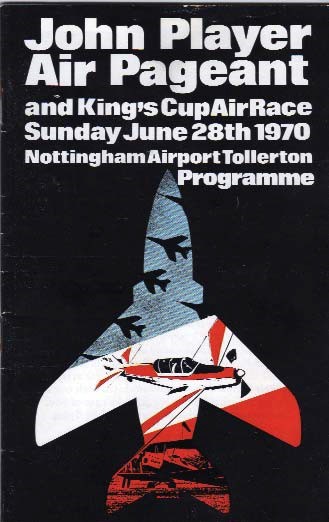There has been an airport in Tollerton since 1929 when Sir Albert Ball sold the land to the City Council for £34 per acre. Sir Albert, father of the famous First World War fighter pilot ace (also called Albert), was a member of the City Council at the time. He had only held the land for less than a year having bought it as part of a larger parcel from the Trustees of the Tollerton Estate. The land covered 141.359 acres.
The aerodrome was officially opened on 27th July 1929 by Sir Alan Cobham, a famous aviator. The Lord Mayor of Nottingham, Alderman Atkey, was flown down to London by Flight Lieutenant R. Lee Bateman, the Flying Instructor of the Nottingham Aero Club, where he was presented with the Air Ministry’s License for Tollerton to officially open the aerodrome. Tollerton was the second municipal aerodrome in the UK to receive an operating License and the first with a permanent site. The first License was issued to Manchester in April 1929. The idea was to have private and commercial flights from and to Tollerton.

The First Flying Club
The first flying club in Nottingham was formed as the Nottingham Aero Club in November 1926 and was based at the military airfield at Hucknall. It was agreed that Tollerton would be a new base although, when the Club moved here, the only facilities were two tents, one of which was used as an office. The aircraft (two DH Moths) were kept at Hucknall and flown to Tollerton daily for members’ use.
The club was absorbed into the National Flying Services (NFS) in 1929 then became the Nottingham Flying Club Ltd in July 1930. Their plans had been to train pilots and have several airports throughout the UK offering air taxi services. Unfortunately, there were financial difficulties which culminated in the NFS being taken over by Receivers. The Club lasted seven years and was dissolved in July 1937. NFS built the clubhouse with a hanger alongside in 1930. Also included was a badminton court as it was felt at
the time that it was a game that helped develop eye and limb co-ordination which was beneficial to a pilot.
The Prince of Wales flew his Puss Moth to Tollerton aerodrome on several occasions when he visited Grove Farm in Lenton which he had bought in 1927. The rumour at the time was that he used it to entertain lady friends. The farm is now part of the University of Nottingham. There was an active social side to the Club with dances, tennis and badminton contests as well as flying competitions. Non-members also had an opportunity to be flown for a fee.
Flying wasn’t only the domain of men – Muriel Robinson was the first woman to gain a pilot’s License at Tollerton (and the first in Nottinghamshire). She took her first solo flight in a Puss Moth at the age of 27 on 7th November 1929 after only eight hours of dual instruction.
Early Pageants
Annual displays and pageants were held at Tollerton Aerodrome between 1930 and 1938. Lots of people came to see the stunts and dare devil displays though wing walking was banned in 1933 as it was deemed too dangerous. Pleasure flights could be taken in a Giant Moth and a Desoutter. The last display was in September 1938 before war came when it was reported that 10,000 people attended the event.
Commercial Flying
Nottingham Airport Ltd was formed in March 1934 and took over the aerodrome. The Nottingham Flying Club was taken over as part of this arrangement.
Crilly Airways started a new daily service between Liverpool (Speke), Leicester, Norwich, Nottingham and Northampton in August 1935. This did not run in the winter months and Tollerton was dropped from its schedule before the start of the 1936 commercial flying season. Crilly claimed that Tollerton’s facilities were not adequate, being too small and landing fees too high.
In 1937, the airport area was increased when more land was purchased from Sir Albert Ball. Further extensions were planned in 1939 but nothing was actually completed before war broke out.
Military Intervention
The first military use of Tollerton aerodrome occurred when Rolls-Royce Ltd of Derby arranged to flight test it’s engines. In 1936, the Government decided that, in the event of war, many more pilots would be needed so civilian training schools were formed in various parts of the country. In 1939, the Air Ministry leased some land at Tollerton aerodrome to build a factory for Rollaston Aircraft Services to act as a repair base and to develop an Elementary Training School.
With the ever-looming threat of another war with Germany, the Government hastily embarked on the training of civilian pilots as quickly as possible. Two schemes were introduced nationwide; the Royal Air Force Volunteer Reserve (RAFVR) and the Civil Air Guard (CAG), both of which were implemented at Tollerton. The RAFVR scheme was only open to young men and those approved for the course undertook to join the RAF as and when required. The CAG scheme was open to men and women of all
ages and it was hoped that those who learned to fly by that route would be available, in the event of war, for various duties for the RAF such as ferrying aircraft, delivering mail, operating an air-ambulance service and ferrying personnel. Nationally, 60 clubs took part in this scheme, Tollerton being one of them. In 1938, 480 people applied to be trained and 250 were accepted.
The Royal Air Force Volunteer Reserve (RAFVR) started in June 1938 where no fee was required to learn to fly. Civilians were trained in their spare time and continued with their normal employment but had to commit to a five year term and agree to enter the RAF in the event of war.
The airport was requisitioned by the Air Ministry in September 1939 when all civilian flying was banned. The CAG & the RAFVR were disbanded and the aerodrome became known as Tollerton Airfield, Nottingham Airport or RAF Tollerton. The site was developed into a major centre for the assembly, modification, overhaul and repair of military aircraft.
Pill Boxes
According to the English Heritage website Tollerton was designated a Class IIa airfield in 1940, probably because of its role as a Field Repair Unit and the need to protect the aircraft stored here. The airfield was described as heavily fortified (Osbourne 2003) and the strong defence system included 19 pillboxes and a machine gun post, once located on top of a water tower. Several of the war time structures have been demolished but 18 of the pillboxes still remain around the periphery of the airfield. It is suggested that it is quite rare for so many pillboxes to have survived in one locality. Because of the special architectural and historic interest they are listed under the Planning Act 1990.

The Pill Box positions around the airfield
Courtesy of ULAS (University of Leicester Archaeological Services) Contains OS data
All of the pillboxes are on private land and in different land ownership. Only a few are visible to the general public from public footpaths and the road. The distance between the pillboxes was calculated according to the range of the weapons for which they were intended. The view from each would have been different; some looking outwards to protect the exterior, while others pointed towards the interior of the airfield. Some of the pillboxes were located within the arable fields just outside the airfield boundary. After the war, farmers were offered £5 for every pillbox they destroyed, but as few took up the offer, they had to enlist the help of the Army to bring them down.
There are three types of pillbox at Tollerton, including nine square pillboxes that are considered to be more unusual. The most unusual one however was a two- storey pillbox that was located inside an early 20th century hangar.


Courtesy of Keyworth & District Local History Society
Not all of the pillboxes survive intact. One of the most common designs (Type 24 above right), was a squat, hexagonal building with special windows called embrasures, which were designed to allow rifle or machine gunfire. Each embrasure has a stepped brick and concrete surface which would have functioned as bullet stops. Conditions would have been cramped for the local Home Guard, which was expected to man them.
Reference: Osbourne, M 2003 20th Century Defences in Britain: The East Midlands
1941 onwards
In January 1941, 12 Squadron was based in Binbrook, Lincolnshire but they relocated part of the Squadron (‘A’ and ‘B’ flights) to Tollerton to continue their training as difficulties were experienced due to heavy flooding. One of the Squadron’s Wellington bombers crashed into the ground close to Cotgrave during a training exercise. The aircraft was on a gunnery training flight when the pilot encountered control problems. The aircraft hit an oak tree just short of the still existing runway, next to where the golf course club house now stands, killing seven people. The squadron returned to Binbrook in March 1941.

This plaque is attached to the side of the pill box close to the airfield control tower listing the dead.
Courtesy of Keyworth & District Local History Society
Three concrete runways and hard standing for two dozen aircraft were put in place in 1941. Extra buildings were built to accommodate the 700 personnel it had at its peak employment. The runways could accommodate some planes but not heavy fully loaded bombers so Tollerton never became a fully operational airfield.
“During the war years, the Harvard training two seater aircraft were always in the air. Their approach to the airfield, and take off, depending on the wind direction, was over our back garden. They were low enough to see the pilots and, on one occasion, one nearly took the roof off the house as it flew at right angles to the other traffic, struggling to stay airborne. I remember seeing a four engined bomber falling in flames in the direction of the city, and also seeing an American Lightning in flames disappearing over Hoe Hill, leaving behind a dangling parachute.
“My father, either in his capacity as a Home Guard member or as a common sightseer, walked to Plumtree to see a downed Spitfire.
“During the night time raids on the city, I was made to sleep in an airing cupboard, listening to the unsynchronized engines which told us that the bombers were German, and listening to the bombs detonating as they destroyed buildings and lives just five miles away.”
Mike Connelly, who lived at Frankley Croft, Tollerton Lane between 1938 and 1947
RAF Newton became a base to the (Polish) Service Flying Training School in 1941 and, as RAF Tollerton was now officially a satellite of RAF Newton, it was used on a regular basis by them. They mainly practised taking off and landing in single engined fighters in Miles Master Mk 111 aircraft and later the American Harvards. As the concrete landing strips were operational, they could do this in all weathers. Some operational missions were flown from Tollerton though they should have taken off from Newton. Due to Newton’s waterlogged grass airfield, the planes were flown to Tollerton, their bombs transported from Newton by road, loaded up and then mission away!
Several local residents were employed at the airfield, one of whom was Miss Don. One of her memories, as recorded in Dick Shepherd’s village publication (1995), refers to her working life at Tollerton Aerodrome during WW2. The following captures just a little of her story, not least because of her encounter with a famous actor and film star. Miss Don initially worked in the cost office at Field Aircraft Services at the airport. The Ministry decreed that the factory should employ a Welfare Officer and she was sent on a six month course to train for this post. With an increased workforce at the airport and many working long hours, it was eventually decided to extend the canteen facilities and Miss Don was put in charge. With wartime restrictions and the varied dietary needs of the workforce, this was quite a challenge.
“One evening she was working late and heard a plane landing which surprised her as night flying at Tollerton was unusual. She was asked to take the ‘drome run-about, an old Opel, into town with the two pilots so that they could put up at the Black Boy Hotel. As she drove into town the Air Raid Alarm sounded and ack-ack fire could be heard. A smell of burning filled the car and they realised there was something wrong so she stopped near the Midland Station. The senior officer of the two stopped an Army truck and commandeered their fire extinguisher with which he put the fire out. The next morning she was told that the Officer had phoned the base and praised the way she had dealt with a difficult situation. It transpired that the Officer was Laurence Olivier and Miss Don had hardly noticed him!“
Excerpt from a Tollerton Village Newsletter 1995
The (Polish) Service Flying Training School was disbanded in November 1945, although Polish pilots, based in RAF Newton, were still being trained for a peace-time force.
Rollaston Aircraft Services
Along with the RAF there was also a civilian workforce – Rollaston Aircraft Services – on the base that the Civilian Repair Organization (CRO) contracted work to on behalf of the Air Ministry to repair, modify, maintain and assemble the aircraft. They worked on and repaired the Handley Page Hampden until it was withdrawn from operation; then they worked on the new Lancaster bombers that were assembled, repaired, modified and overhauled. Between 1939 to 1945 it is believed that contracts involving approximately 1,700 aircraft and 2,000 components were completed for the Ministry of Aircraft Production although there are no official records to show this. This figure represents a significant contribution to the war effort by the employees of RAS.

Lancaster fuselages being assembled in the Main Hangar Courtesy of Keyworth & District Local History Society
At the end of the war many aeroplanes were cut up for scrap and Tollerton specialised in the break-up of Lancasters. At one time the south westerly corner of the airfield was one huge graveyard of destroyed Lancasters. Tollerton was finally derequisitioned by the Air Ministry in 1960.
After the War
Civilian flying then resumed and the Nottingham Flying Club returned too but was shortly disbanded. The repair factory continued to service and repair civilian aircraft and converted ex-Military aircraft for civilian use but eventually the runways proved too short for the larger aircraft so they moved to larger airfields. The RAF returned in 1949 for training pilots of No. 22 Flying Training Squadron and had unrestricted use of the airfield greatly reducing civilian flying.
The Field Consolidated Aircraft Services that were dismantling the Lancasters became Tollerton Aircraft Services (TAS) and continued to repair private planes but, by then, the workforce was down to around twenty people. A lot of work focused on converting war aircraft for civilian use. By 1950 the workforce had increased to 500 people. TAS won a contract in 1953 to refurbish 100 Dakotas for the United States Airforce (updating them for military use) which was renewed for the next few years. They also started on-site recovery operations all over the world and some planes came back to Tollerton to be repaired. With all this success in business, Tollerton airfield was becoming too small for all the work coming in so the main business was moved to Wymeswold in 1958.
The Government had earmarked Tollerton to become a national airport at one time but, as aviation became more advanced and airplanes became bigger, Tollerton was considered too small to cope.
Four small independent airlines operated out of Tollerton but, with excellent road and rail services around Nottingham at that time, flights were not in great demand so none of them stayed in business for long.
In September 1950 Eagle Aviation took over one of the failed airlines but no flights were taken from Tollerton. The Eagle Flying Club took over the clubhouse but it was a flying club in name only. It had many members who used the airfield but had no direct involvement in flying and it was used as a social club until the mid-sixties.
Truman Aviation
The Sherwood Flying Club started in 1956 and with it the resurgence of private aircraft flying. Truman Aviation Limited eventually took over the lease after the land reverted back to Council ownership in 1963. The airfield continued to be known as Nottingham Airport Ltd then changed to Nottingham Tollerton Airport.
Interestingly, the council gave consideration at that time for the airport to be developed for housing but decided against it as there was sufficient development elsewhere for the projected needs of Nottingham.
Truman Aviation was given a 75 year lease and the owner, Derek Truman, had plans to develop a fly-in leisure centre complete with a 122 bedroom hotel, golf course and indoor arena offering ten-pin bowling, archery and artificial ski slopes but these never materialised.
The Eagle Flying Club became Tollerton Flying Club and continued its social activities. A control tower was erected and the Piper agency commenced with the launch of an air taxi service. Piper, an American firm, specialised in making light aircraft and became very popular with amateur flyers. The first planes Truman Aviation bought were Piper planes and they became the leading British dealer in the Midlands and the North.
Derek Truman revived the annual summer air pageants between 1967 and 1980. The first helicopter race took place here in 1967 and was the first one ever to take place in the UK. It was also the year the King’s Cup Air Race came to Tollerton for the first time as part of the annual weekend pageant normally held in the summer. The Red Arrows made their first appearance at Tollerton in 1968 and Concorde flew over in 1985. There were also ground events and displays. The 1990 pageant marked the airfield’s 60th anniversary with a special programme but attendance was disappointing partly because people did not pay to get in but instead parked down the road and watched the displays from there. When the 1993 pageant made a loss of £8,000, a halt was called to future pageants. Occasionally ‘fly-ins’ are organised in which light aircraft enthusiasts from all over the country come to meet other like minded people and look at their aircraft.
In 1980 Derek Truman retired and sold Truman Aviation Ltd to Arrowband Equipment Ltd of Nottingham whose subsidiary was Leatherland Business Equipment of Castle Boulevard. The sale increased the lease of the airfield which had been renewed two years earlier. Derek Leatherland, the managing director, had been an instructor in the Spencer Flying School that had been based at Tollerton and also owned a Tiger Moth. The directors decided to retain the name of Truman Aviation and, in 1984, a new lease was agreed to run for 30 years.
The Nottingham Flying School had replaced the Spencer Flying School which then became the Truman Flying School. Currently it is the Sherwood Flying Club, one of eight branches in the country. The company Aeros which has been here since January 2013, is also at the airport. They have five flying instructors for Private Pilot and Commercial Pilot License courses and training to fly starts on a single engine plane. Experience flights and helicopter lessons are also available.


Courtesy of Keyworth & District Local History Society
The Air Training Corps (ATC)
This was formed in 1965 and moved into the Main Hangar at Tollerton Airfield in 1966 but, due to a fire in the offices above, moved to the north side of the Main Hangar in 1984. The ATC attracts boys and girls with an interest in aviation and other activities. The local Squadron commemorated its 50th anniversary in 1991 by dedicating a plaque on the bunker near the control tower – ‘to all who served at Tollerton Airfield during World War II.’ This is the same bunker that has a plaque in memory of those who died when their Wellington bomber crashed near Tollerton in February 1941. The ATC are still active today and always lead the parade on Remembrance Day down from Medina Drive to the Church and salute the Memorial.
The Clubhouse
You did not need to be a pilot or trainee to enjoy the facilities at the clubhouse. It had been requisitioned by the RAF when they were in occupation and reverted back to a clubhouse once they had left the aerodrome. The clubhouse originated in the 1930s. Its name changed as time went on from the Tollerton Flying Club, the Tollerton Country Club in the 1970s and the Rob Roy Steak House in the early 80s. It burnt down in 1982 from an electrical fault that started a fire in the roof. The fire brigade could not do much other than prevent the blaze from spreading to adjoining buildings. The 30 customers who were inside enjoying their meals all escaped unharmed. A new two storey building was erected soon afterwards and re-opened as the Tiger Moth restaurant. In 2004 it changed hands and became Miahs, an Indian restaurant and then was not exclusively a clubhouse but open to all members of the public. It is still an Indian restaurant and presently called The Spice Barn.
Airfield post 2006
In 2006, Nottingham City Council announced that it proposed to sell the airfield. The winning bid of around £5 million was made by Nottingham City Airport plc and they took ownership of the buildings, runways and most of the land. Part of the land is still owned by Nottinghamshire County Council and leased to the airport. Truman Aviation leases the airport and continue to direct all aviation activity on the airfield. Nottingham City Airport develops and maintains aviation and other facilities.

Aerial view of the airport courtesy of Keyworth & District Local History Society
A further 113 acres was sold to Nottingham City Airport plc for £700,000 in 2008. The intention was to lengthen the runway from 1000m to 1500m to accommodate larger international aircraft alongside a 300,000 sq ft business development.
Several businesses still operate out of the airfield and, even though East Midlands Airport was renamed as Nottingham Airport, there has not been too much confusion with the airport in Tollerton.
Our great thanks go to the authors of ‘Tollerton an airfield for Nottingham 1929 to 2007’ by Howard Fisher, Bob Hammond & Nigel Morley; their book was used to obtain some of the highlights for this section of our publication.
At the time of this publication the Borough Council has approved development of the north end of the village which includes the airport but the precise nature and scale is, as yet, unknown.